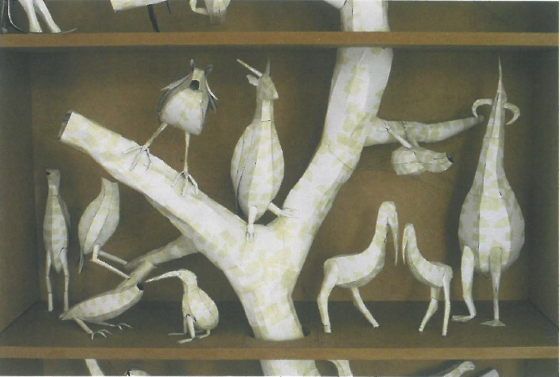
Emerging artists in Adelaide often show in less conventional spaces beyond the gallery circuit, such as shop@rt, artEast, as well as nightclubs, motels, shops or salons - not just for the sake of being alternative, but often from a lack of available supportive venues. There are, however, some new art friendly spaces on the gallery run that regularly house the work of South Australia's emerging artists. Two of these; downtown art space and The Project Space (of the CACSA) have recently shown work from several of Adelaide's emerging artists.
At The Project Space, Kate Morkunas' catching trains... alludes to common phrases, associations and visual puns related to travel, maps and handkerchiefs. In this installation the hankies, printed with the lines of local and international roadmaps, are prominent, since everything else (the seating, the desk, the shelves and even movement) has been reduced down to its wiry skeletal essence. Morkunas' shaped wire stands for checked, embroidered and faded hankies, props them into their fleeting floating state forever: capturing the uncatchable. While the space sits bare, the furniture is devoid of planes and practicality and the maps lose the three dimensionality of life, the hankies in catching trains... show the desire to recreate memories and to hold onto them long after substance and reality have left.
Likewise, the work in downtown art space of Julia Robinson and Morgan Allender in Petrified Nature and Louise Flaherty in birds and bees attempts to capture; this time the natural. Inextricably linked by their fascination of grasping or moulding the finer details of nature, these artists loop nature to repeat over and over or alter it to fit somewhere between the dichotomy of the natural/cultural.
Flaherty's Birds and Bees installation consists of two short films projected low on the gallery wall; one projection, a small bird chirping in a leafless tree, the second, a busy group of bees buzzing around a yellow pollen-filled flower. On the opposite wall, inverse to the films' directness, quietly sits a flock of white calico seed bags embroidered with thirty distinct bird varieties. Nicely poetic, the small bags perch on white shelves with their intricately sewn depictions matching the sounds of twittering bird names (eg brindled tern, splendid wren and singing bushlark). Flaherty's two-part installation uses the oppositional natures of soft and meticulous, and bold and immediate, to concentrate on our cultural understandings of bird nature.
Allender and Robinson's work in Petrified Nature is combined in the front space of downtown to create a museum feel; a place of small curiosities, stuffed animals and looming landscapes. There are no stuffed animals, however, only doe, one of Allender's three large oval paintings. Depicting an inert doe's upper torso, this painting recalls mounted trophies hung to show off a hunter's prized kill. Allender's A drop of golden sun, seems also to be holding captive snippets of nature. A landscape, this time, loosely painted with a minimal palette, is recast and reconsidered from nature and given a slickness that is undoubtedly contemporary.
Robinson, in Propositional Nature, puts forth a curious display of bird/frog/nameless little creatures scattered around a tree branch, all made of paper and tape; they are propositional as their form serves as a suggestion of living things yet to take on solidity and actuality. The use of paper, tape and lead pencil sketching, housed in an unpainted MDF case, suggests that this is a mock-up of sorts, where the mode of display is as crucial as the creatures themselves. These headless birds and smaller birds with frog-type legs or hoof-like footing, are, like Louise Weaver's culturally morphed animals or Fiona Hall's tupperware beings, cultural creatures and a sign of nature giving way to culture.
Such spaces as downtown and The Project Space give artists of varying degrees of emergence the opportunity to show new truly experimental art. Emerging artists give us a peek into art future - and you never know what to expect.












